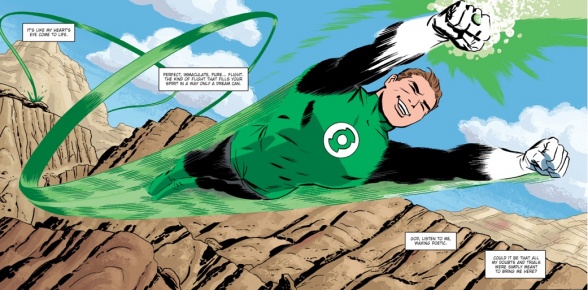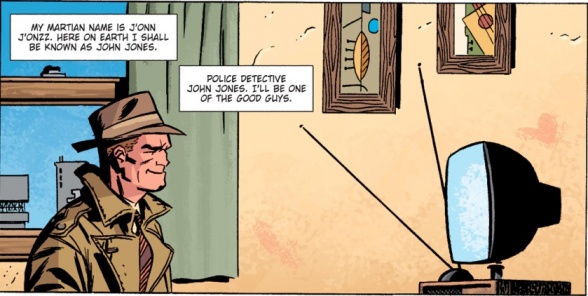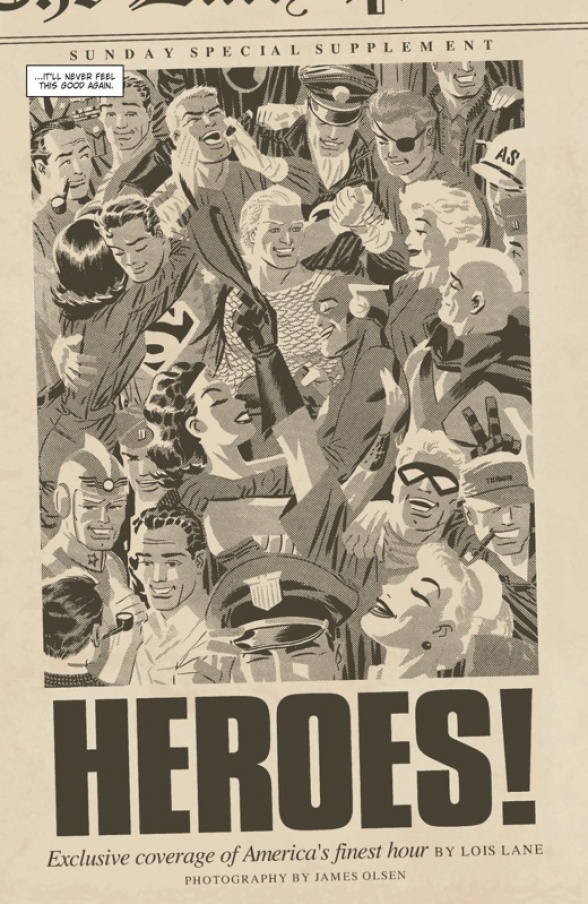Recapturing the Magic
What Superhero Comics Today Could Learn from Darwyn Cooke’s “DC: The New Frontier”
This article first appeared on Multiversity Comics on September 16, 2014, but was written by me. It has been published here as well with their very kind permission.
Any Darwyn Cooke comic work is something worth celebrating, as the guy is one of the absolute titans of comics today, and last week, DC revealed that we’d be getting more in the form of 23 variant covers that highlight his take on an array of their titles. From what we’ve seen, they’re utterly spectacular, and they show off some of the things that make his superhero work so special.
But when I look at those covers, I’m hit with a dour mood after my immediate glee. I can’t help but wonder, why aren’t superhero comics today more like the way Darwyn Cooke sees them? When I see the faces on the superheroes he depicts, I see something unfamiliar: happiness. And it’s weird how foreign that really is for the heroes not only at DC, but at Marvel as well. That feeling led me to reread one of my favorite comics ever – Cooke’s “DC: The New Frontier” with Dave Stewart, J. Bone and an array of others – and while reading that, it underlined that feeling even more, especially when I read this line in Cooke’s Afterword in the second volume paperback:
“I’m 42 now, and I suppose that I believe that the magic of this specific genre is based on the notion that seven powerful people can work together to make the world a better place. That they will do the right thing no matter what the personal cost, no matter how ‘grim and gritty’ the world around them becomes. They are the heroic ideal.”
Cooke wrote that in 2005, and in nine short years, it’s odd how foreign that write-up feels when looked at through the prism of today’s superhero comics. Both Marvel and DC have embraced the grim and gritty above all, with the sentiment of working together to make the world a better place feeling out of place in an era with events built around wiping the memories of some of the greatest heroes (this happened twice!).
Part of that assuredly is meant to reflect modern times, as the concept is an archaic one in a day and age where strife is so omnipresent that many try to find it when none is apparent. But the idea of superheroes is meant to go beyond that, isn’t it? Characters like Superman or Captain America are meant to be the very best of us, representing the ideals that we most want for ourselves. They’re meant to be people who readers can look up to; who kids can turn to when struggling with determining what’s right or wrong.
Often times when I read superhero comics today, I don’t even recognize the characters I once learned from as a kid. When you read something like the New 52 relaunch of “Justice League” or a lot of Hickman’s Avengers World work in “Avengers” and “New Avengers”, lead characters like Batman & Superman and Captain America & Iron Man are regularly working against each other instead of together for the betterment of humanity. These characters, who are the leaders of the greatest superhero teams in comics, are frequently better examples of the failure of the heroic ideal than its fulfillment.
Reading “The New Frontier” highlighted my disconnect with these characters more than ever, and it goes back to that lacking element I mentioned earlier: happiness. You read that book, and characters like Barry Allen and Hal Jordan aren’t just limitless fight machines deterring villains from reaching their goals; they’re living, breathing people with real lives finding joy where they can. They fight because they’re trying to do something good for the world, as they aren’t just plot devices with superpowers. They’re people first, and people that are trying to do real good with the special circumstances they have been met with.
And by god, they smile! It’s weird how strange that feels to see in a comic, but think about the last major event comic you read, and then try to think of one time where a character smiled. With a big stack of comics directly in front of me, I tried to find one instance where anyone did in a main thread Marvel or DC book, and I couldn’t find one. Reading “The New Frontier” had me grinning along with them, in a way I just don’t often do anymore.
The last comic I can really think of that consistently felt like what Cooke was describing and how he depicted superheroes was Jason Aaron’s run on “Wolverine and the X-Men”. His work with Nick Bradshaw, Chris Bachalo and more found heroes in training being pushed to achieve things they didn’t think they were capable of, but in the process, he captured some of that magic Cooke spoke of. These were characters that had normal lives, and taking time to look at that normalcy – particularly in one joyous issue when Bobby Drake and Kitty Pryde went on a date – made all of the battles and drama feel like they were worth something. Those moments gave the heroes something worth fighting for.
I understand why they fight. I understand why someone like Martian Manhunter from “The New Frontier” would fight for his adopted world, whose journey to understand humanity through television, detective work and a special friendship forged through chess is my favorite part of the entire comic. But why do characters today fight, besides the fact that we have years of continuity dictating that it’s just what they do?
When I was reading “The New Frontier”, an idea popped into my head and I had a hard time getting it out: what if that was the book that had led into the New 52, not “Flashpoint”? What if Cooke’s work on characters like Martian Manhunter or Adam Strange or King Faraday (who is infinitely more interesting in the hands of Cooke than he is in “Future’s End”) provided the blueprint for what came next at DC? Now, obviously there are some slight timing issues – the story is very much set in a specific time – so it wouldn’t really work, but all of the foundations of an accessible, new reader friendly universe are right there, and with it, a hope, optimism and reason to fight that is almost completely devoid in the line presently.
It’s an impossible wish. I know that. But that doesn’t mean that superhero comics today couldn’t learn something from what Cooke accomplished with that remarkable book. He created a modern classic by building from the characters out, making us connect with them as people before the power rings and the superpowers. He looked at the core of each character – the pure and simple elements that make them them – and he built a narrative around what they would do in the time of a crisis.
Too often, superhero comics are more about the crisis than they are about the characters. When you think of the high notes for both Marvel and DC’s oeuvre – things like Morrison and Quitely’s “All-Star Superman”, Miller and Mazzucchelli’s “Batman: Year One” or Brubaker and Epting’s “Captain America: The Winter Soldier” – you think of books that are built just the same as Cooke’s classic. Sure, eventful things happen, but they’re built around the core cast members and their relationships as they try to make the world a better place.
When you look at “DC: The New Frontier” and Cooke’s variant covers that are coming down the path, it’s hard not to describe them with phrases like “nostalgic blasts” and “delightfully Silver Age.” That’s fair, as that’s what they are. They represent another time, and they do it well. But when I look at them, it’s hard not to recognize that the spirit and heart he captures in his work is something comics truly miss. In an era where social media and 24/7 news networks and in-your-face blogs are pursuing the horrors of the world to greater depths than ever before, a little bit of hope and optimism from the greatest heroes in comics feels more needed and welcome than ever.
After all, who today couldn’t use a reminder every once in a while that if people work together, they can accomplish incredible things?
I know I could.



